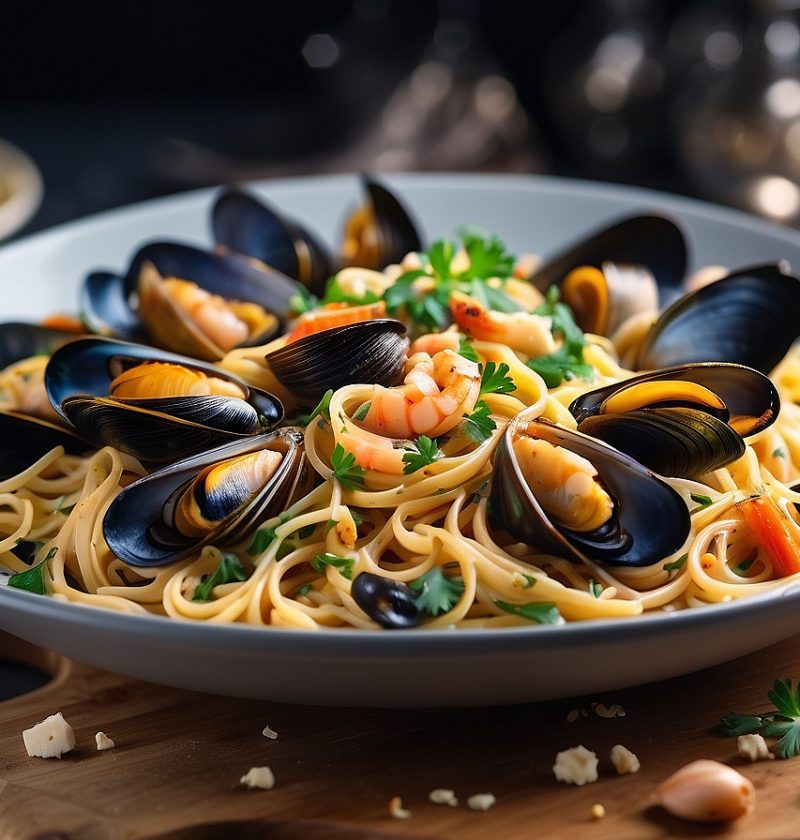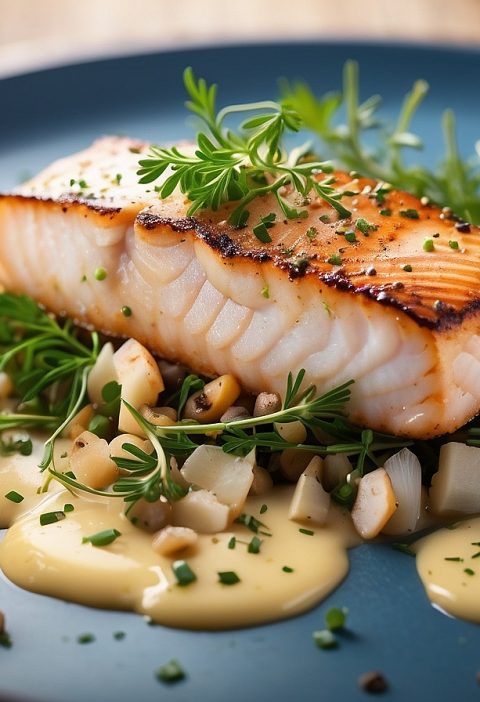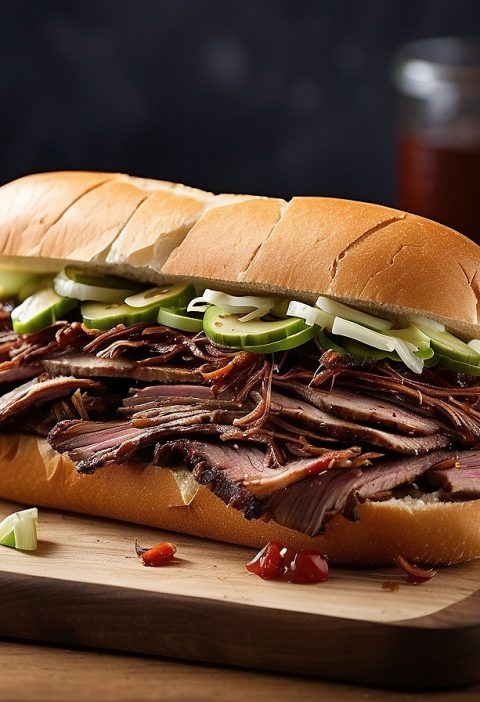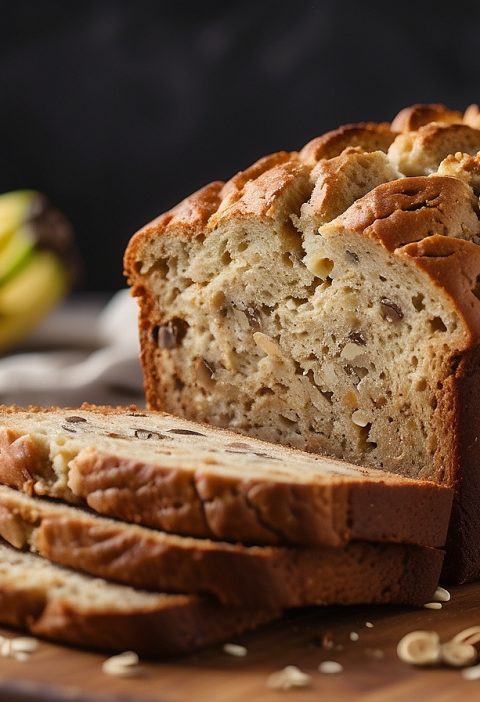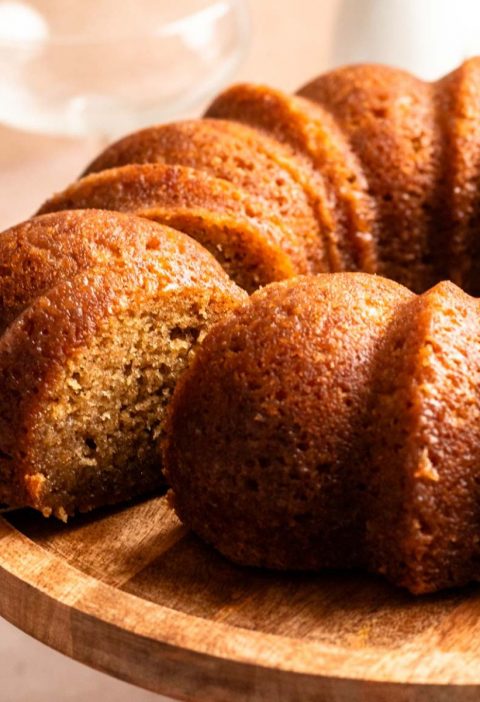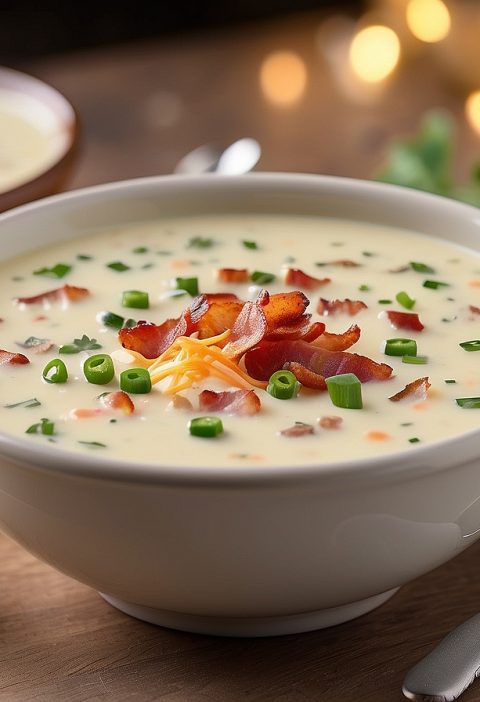Indulge in the flavors of the sea with our tantalizing Linguine with Mussels Pasta recipe. This dish combines the briny goodness of mussels with perfectly cooked linguine pasta, creating a culinary masterpiece that will transport you to the shores of Italy. Each bite is a celebration of the ocean’s treasures, with tender mussels nestled in a savory sauce that clings to the al dente pasta. This recipe is a seafood lover’s dream, bringing together the fresh taste of the sea with the comfort of a classic pasta dish.
Difficulty: Intermediate
Prep Time: 20 minutes
Cooking Time: 20 minutes
Serving: 4
Yield: 4 servings
Calories: 450 per serving
Ingredients:
- 12 ounces (340g) of linguine pasta
- 2 pounds (900g) of fresh mussels, cleaned and debearded
- 2 tablespoons (30ml) of olive oil
- 4 cloves of garlic, minced
- 1 small onion, finely chopped
- 1 cup (240ml) of white wine
- 1 cup (240ml) of fish or vegetable broth
- 1 can (14 ounces / 400g) of diced tomatoes
- 2 tablespoons (30g) of butter
- 1/4 cup (15g) of chopped fresh parsley
- Salt and pepper, to taste
- Crushed red pepper flakes (optional, for spice)
Equipment:
- Large pot for boiling pasta
- Colander for draining pasta
- Deep skillet or sauté pan with a lid
- Wooden spoon or spatula
- Tongs for handling mussels
- Garlic press (optional)
Step-by-Step Guide:
Step 1: Prepare the Linguine
- Fill a large pot with water and bring it to a boil over high heat.
- Add a pinch of salt to the boiling water.
- Cook the linguine pasta according to the package instructions until al dente.
- Drain the cooked pasta in a colander and set it aside.
Step 2: Sauté the Aromatics
- Heat olive oil in a deep skillet or sauté pan over medium heat.
- Add minced garlic and chopped onion to the pan.
- Sauté for 2-3 minutes until the onion becomes translucent and the garlic is fragrant.
Step 3: Cook the Mussels
- Add the cleaned and debearded mussels to the skillet with the sautéed aromatics.
- Pour in the white wine and fish or vegetable broth.
- Cover the skillet with a lid and cook for 5-7 minutes.
- Shake the skillet occasionally to ensure even cooking.
- Discard any mussels that do not open after cooking.
Step 4: Create the Sauce
- Remove the cooked mussels from the skillet and set them aside.
- Add the diced tomatoes to the skillet with the remaining liquid.
- Stir in the butter and season with salt, pepper, and crushed red pepper flakes (if desired).
- Simmer the sauce for 5 minutes to allow the flavors to meld together.
Step 5: Combine the Pasta and Sauce
- Add the cooked linguine pasta to the skillet with the tomato sauce.
- Toss the pasta gently to coat it evenly with the sauce.
- Return the cooked mussels to the skillet and toss them with the pasta.
- Cook for an additional 2-3 minutes to heat the mussels through.
Tips and Tricks:
- Serve the Linguine with Mussels Pasta with a sprinkle of fresh parsley on top for a burst of freshness.
- If you prefer a spicier dish, add crushed red pepper flakes to the sauce or serve them on the side for individual customization.
- Make sure to discard any mussels that remain closed after cooking, as they may not be safe to eat.
- Serve crusty bread alongside the pasta to soak up the delicious sauce.
Nutritional Information:
- Calories: 450 per serving
- Fat: 12g
- Carbohydrates: 54g
- Protein: 27g
- Fiber: 4g
Final Thoughts:
Linguine with Mussels Pasta is a delightful seafood dish that combines the freshness of mussels with the comfort of linguine pasta. The briny flavors of the sea meld perfectly with the savory tomato sauce, resulting in a dish that is both elegant and satisfying. Treat yourself to this seafood extravaganza and experience the joy of a seaside feast right in your own home.
FAQ:
Q1: Can I use frozen mussels instead of fresh ones?
A1: Fresh mussels are recommended for this recipe to achieve the best flavor and texture. However, if fresh mussels are not available, you can use thawed frozen mussels as a substitute. Just make sure to follow the package instructions for cooking and adjust the cooking time accordingly.
Q2: Can I use a different type of pasta instead of linguine?
A2: Absolutely! While linguine is traditionally used for this recipe, you can experiment with different types of pasta such as spaghetti, fettuccine, or even penne. The choice of pasta can alter the overall texture and mouthfeel of the dish, so feel free to choose the pasta shape that suits your preference.
Q3: Can I use red wine instead of white wine?
A3: White wine is commonly used in this recipe to complement the flavors of the seafood and the lightness of the sauce. However, if you prefer the taste of red wine, you can certainly use it as a substitute. Keep in mind that the flavor profile of the dish may be slightly different, but it can still be delicious in its own way.
Q4: Can I make this dish ahead of time?
A4: While this dish is best enjoyed immediately after preparing, you can cook the mussels and prepare the sauce ahead of time. When you’re ready to serve, simply reheat the sauce, cook the pasta, and combine everything together. This way, you can save time without compromising the quality of the dish.
Q5: Can I add additional seafood to the dish?
A5: Absolutely! If you want to enhance the seafood experience, you can add other seafood ingredients such as shrimp, clams, or scallops to the dish. Just ensure that the additional seafood is cooked properly and adjust the cooking time accordingly to avoid overcooking.
Q6: Can I make this recipe vegetarian or vegan?
A6: This recipe is focused on the combination of mussels and pasta, which makes it challenging to achieve the same flavor profile without seafood. However, you can try substituting the mussels with plant-based alternatives, such as marinated tofu or tempeh, to create a vegetarian or vegan version. Adjust the flavors and seasonings to suit your taste preferences.
Q7: Can I freeze the leftovers?
A7: It is not recommended to freeze the leftovers of this dish, as the texture and quality of the mussels and pasta may deteriorate upon thawing and reheating. It is best to enjoy this Linguine with Mussels Pasta recipe fresh.
Q8: Can I use canned mussels instead of fresh mussels?
A8: Fresh mussels are preferable for their taste and texture. Canned mussels may have a different flavor and texture, and they are often preserved in oil or brine, which can alter the overall taste of the dish. It is recommended to use fresh mussels for the best results.
